Abstract
OBJECTIVES: To investigate the cause of sporadic motor neuron disease (MND) by twin study, so allowing (1) estimation of the genetic contribution, and (2) collection of matched pairs for a case-control study of possible environmental factors. METHODS: 10872 death certificates bearing the diagnosis MND were collected from 1979 to 1989 inclusive. Inspection of individual birth entries allowed identification of potential twins. The status of each co-twin was determined and contact made through the National Health Service Central Register (NHS-CR) and their general practitioner (GP). The diagnosis of MND was verified via the co-twin and relatives, and medical records where available. Zygosity was assessed using a recognised questionnaire. Details concerning environmental exposures and health were gathered by interview of cotwin and relatives using a semistructured questionnaire. Heritability (h2) of MND was estimated, and the environmental information was analysed by conditional logistic regression modelling. RESULTS: Seventy seven probands were identified, of whom 26 were monozygotic and 51 dizygotic. Four monozygotic probands were concordant, but two probands came from a family known to have familial MND. The estimated heritability was between 0.38 and 0.85. Most environmental risk factors were not significant. Regular vehicle maintenance (odds ratio (OR) = 7.0; 95% confidence interval (95% CI) 1.3-89.9) and occupational paint usage (OR = 3.75; 95% CI 1.0-17.1), however, occurred significantly more often in the affected cases. CONCLUSIONS: This "death discordant" method for twin collection has proved to be viable, and has allowed the ascertainment of a large population sample in a rare disease. The genetic role in sporadic MND is substantial, and higher than expected. Exposure to industrial chemicals, particularly constituents of petrochemicals and paints, may contribute to the aetiology of MND.
Full text
PDF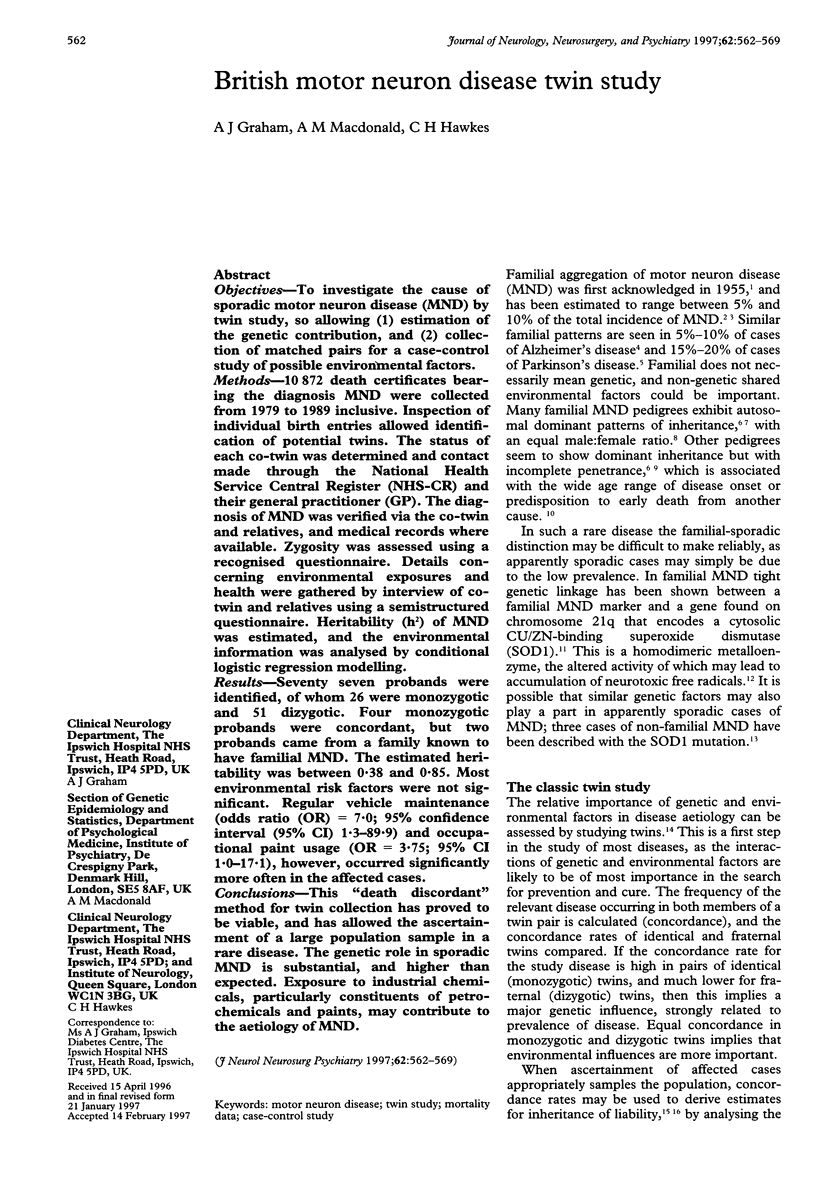
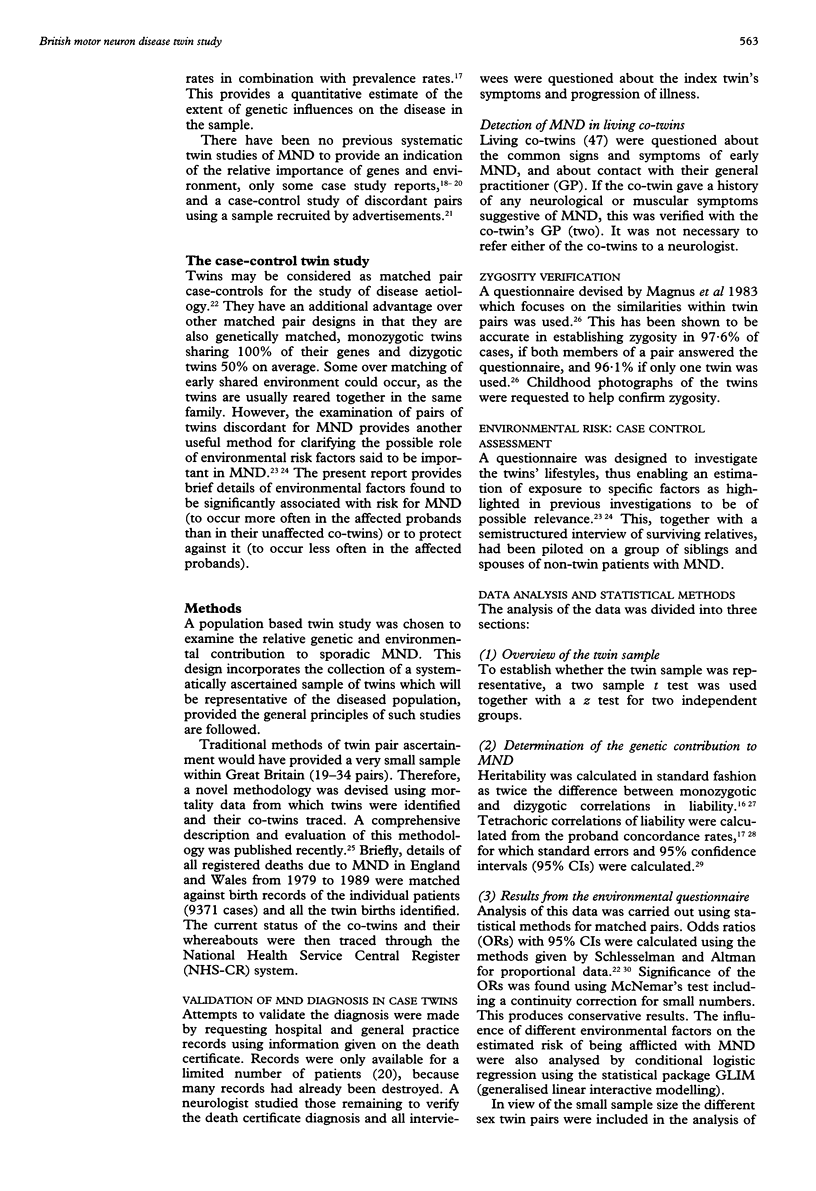
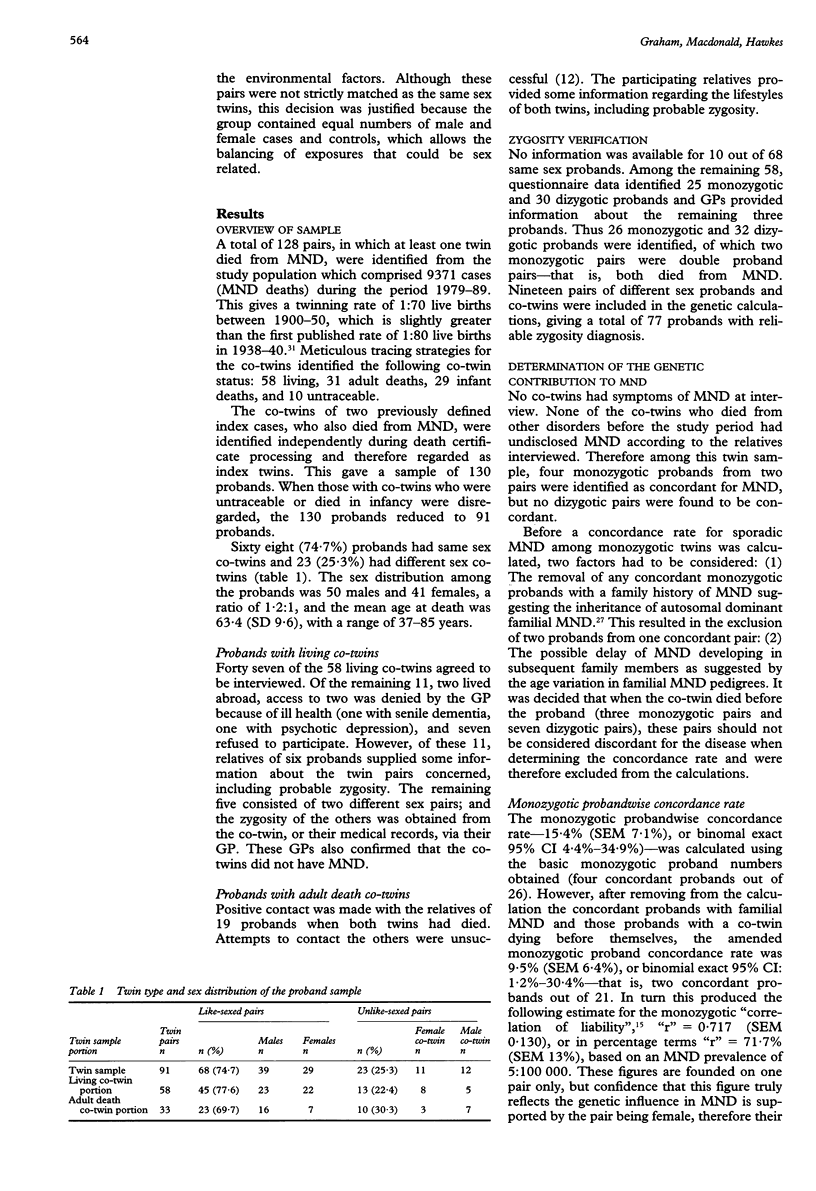
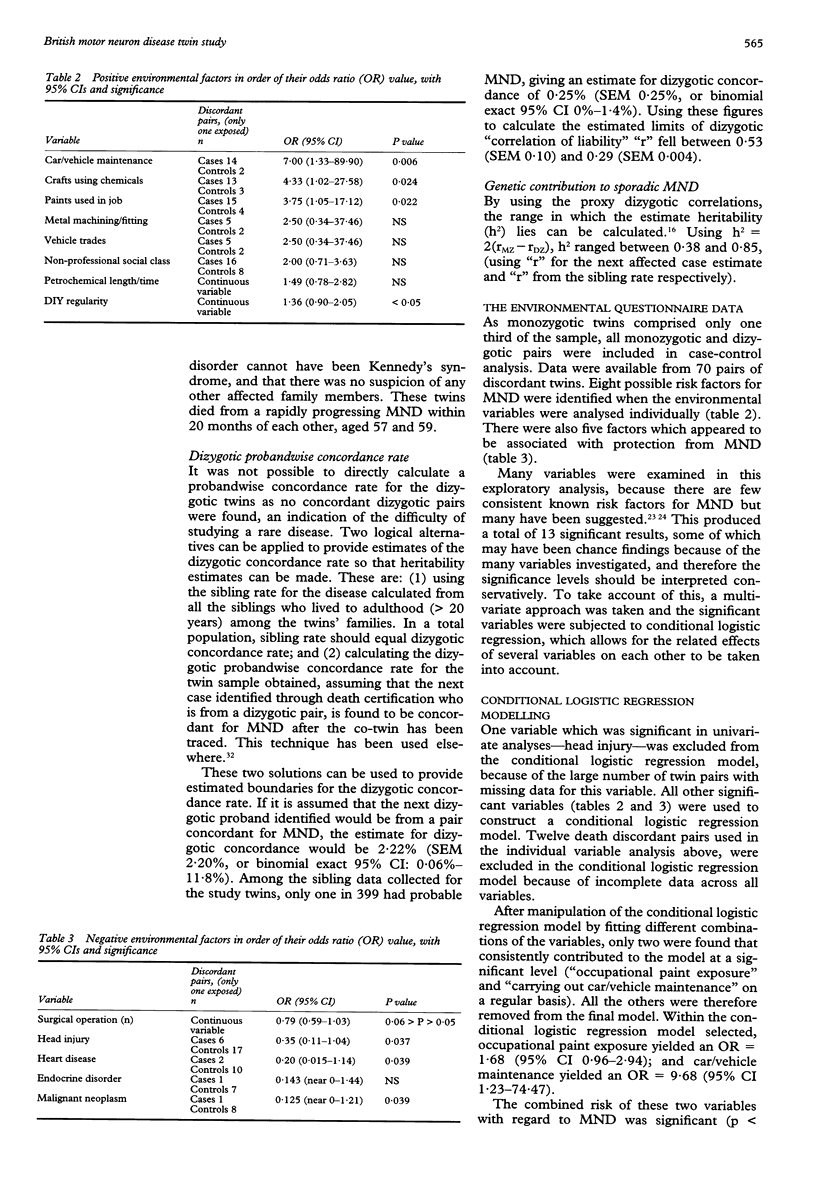
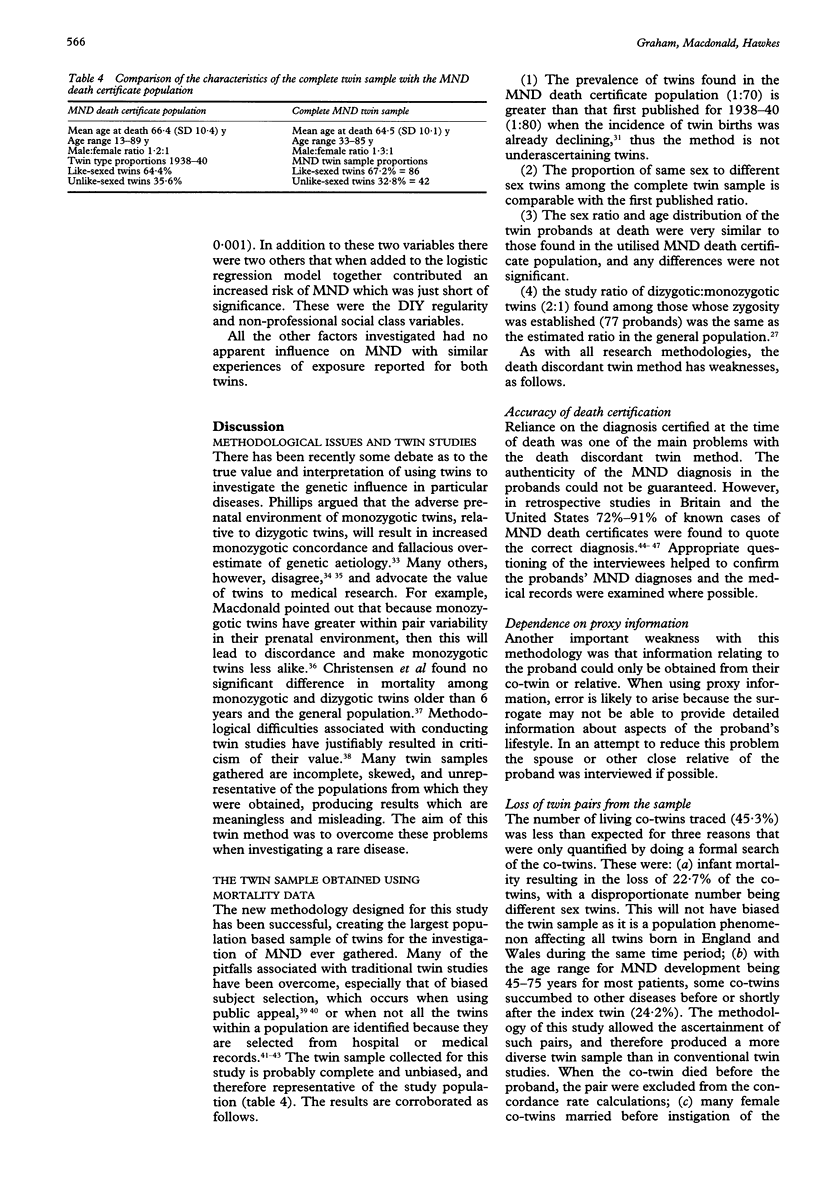
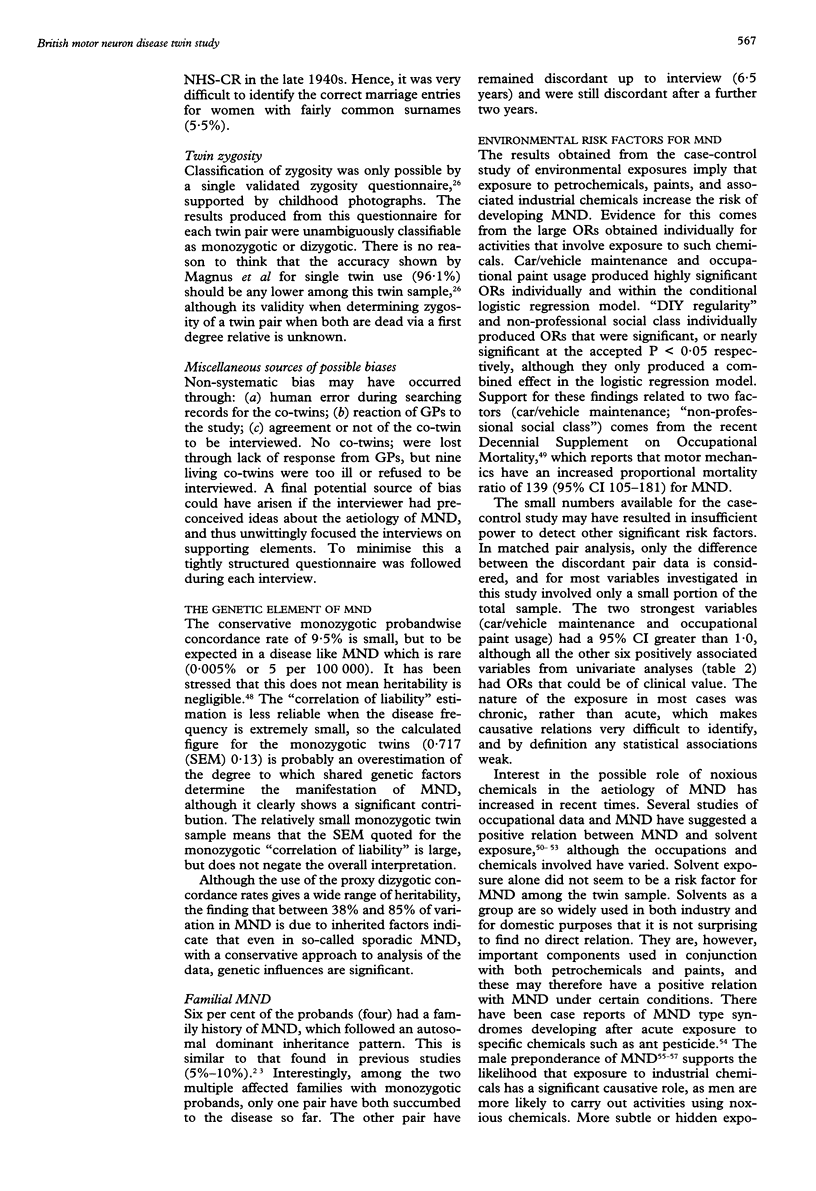
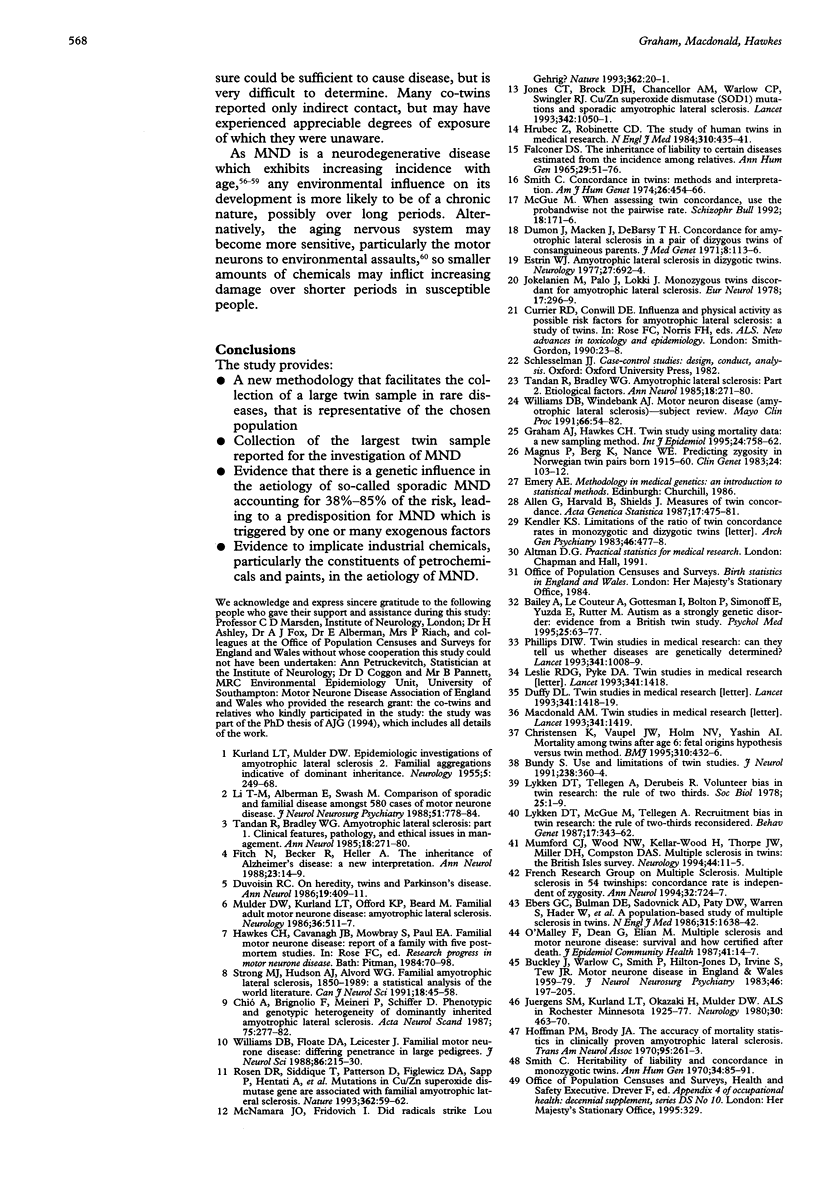
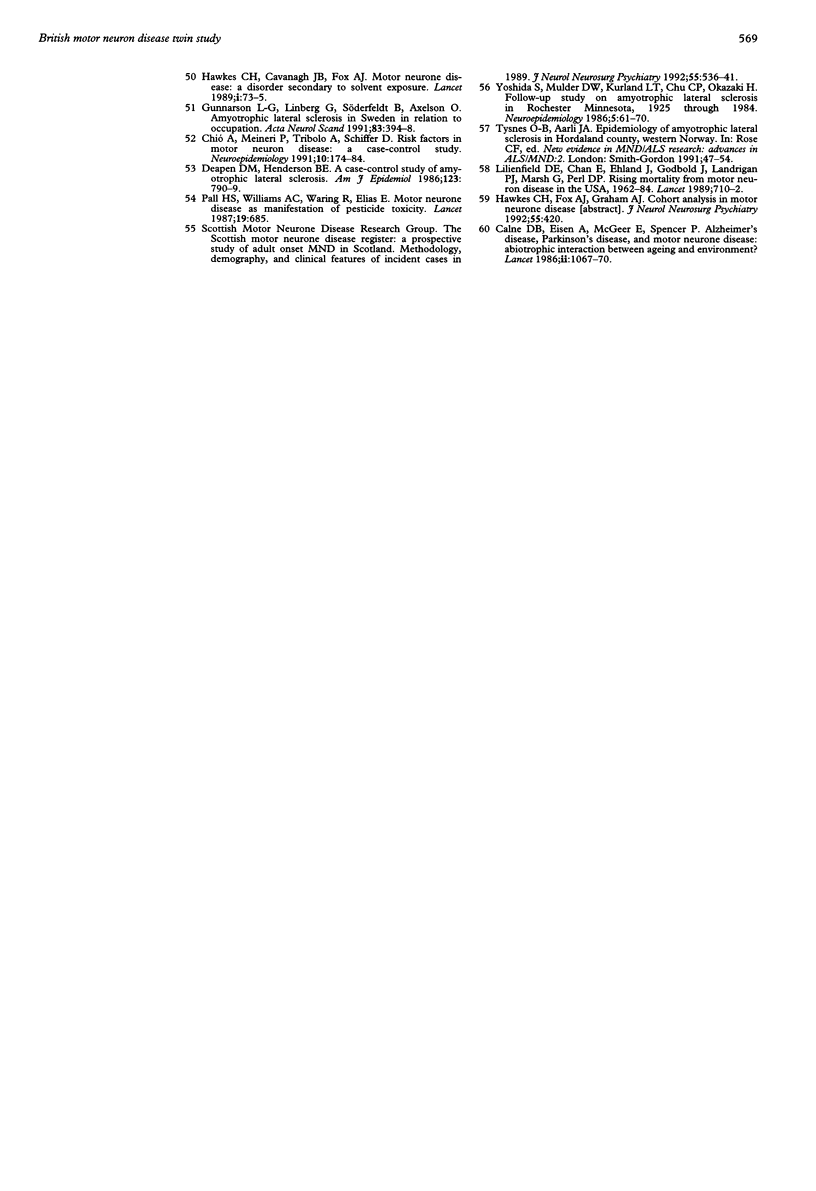
Selected References
These references are in PubMed. This may not be the complete list of references from this article.
- Allen G., Harvald B., Shields J. Measures of twin concordance. Acta Genet Stat Med. 1967;17(6):475–481. doi: 10.1159/000152101. [DOI] [PubMed] [Google Scholar]
- Bailey A., Le Couteur A., Gottesman I., Bolton P., Simonoff E., Yuzda E., Rutter M. Autism as a strongly genetic disorder: evidence from a British twin study. Psychol Med. 1995 Jan;25(1):63–77. doi: 10.1017/s0033291700028099. [DOI] [PubMed] [Google Scholar]
- Buckley J., Warlow C., Smith P., Hilton-Jones D., Irvine S., Tew J. R. Motor neuron disease in England and Wales, 1959-1979. J Neurol Neurosurg Psychiatry. 1983 Mar;46(3):197–205. doi: 10.1136/jnnp.46.3.197. [DOI] [PMC free article] [PubMed] [Google Scholar]
- Calne D. B., Eisen A., McGeer E., Spencer P. Alzheimer's disease, Parkinson's disease, and motoneurone disease: abiotrophic interaction between ageing and environment? Lancet. 1986 Nov 8;2(8515):1067–1070. doi: 10.1016/s0140-6736(86)90469-1. [DOI] [PubMed] [Google Scholar]
- Chio A., Brignolio F., Meineri P., Schiffer D. Phenotypic and genotypic heterogeneity of dominantly inherited amyotrophic lateral sclerosis. Acta Neurol Scand. 1987 Apr;75(4):277–282. doi: 10.1111/j.1600-0404.1987.tb07933.x. [DOI] [PubMed] [Google Scholar]
- Chió A., Meineri P., Tribolo A., Schiffer D. Risk factors in motor neuron disease: a case-control study. Neuroepidemiology. 1991;10(4):174–184. doi: 10.1159/000110267. [DOI] [PubMed] [Google Scholar]
- Christensen K., Vaupel J. W., Holm N. V., Yashin A. I. Mortality among twins after age 6: fetal origins hypothesis versus twin method. BMJ. 1995 Feb 18;310(6977):432–436. doi: 10.1136/bmj.310.6977.432. [DOI] [PMC free article] [PubMed] [Google Scholar]
- Deapen D. M., Henderson B. E. A case-control study of amyotrophic lateral sclerosis. Am J Epidemiol. 1986 May;123(5):790–799. doi: 10.1093/oxfordjournals.aje.a114308. [DOI] [PubMed] [Google Scholar]
- Duffy D. L. Twin studies in medical research. Lancet. 1993 May 29;341(8857):1418–1419. [PubMed] [Google Scholar]
- Duvoisin R. C. On heredity, twins, and Parkinson's disease. Ann Neurol. 1986 Apr;19(4):409–411. doi: 10.1002/ana.410190422. [DOI] [PubMed] [Google Scholar]
- Ebers G. C., Bulman D. E., Sadovnick A. D., Paty D. W., Warren S., Hader W., Murray T. J., Seland T. P., Duquette P., Grey T. A population-based study of multiple sclerosis in twins. N Engl J Med. 1986 Dec 25;315(26):1638–1642. doi: 10.1056/NEJM198612253152603. [DOI] [PubMed] [Google Scholar]
- Estrin W. J. Amyotrophic lateral sclerosis in dizygotic twins. Neurology. 1977 Jul;27(7):692–694. doi: 10.1212/wnl.27.7.692. [DOI] [PubMed] [Google Scholar]
- Fitch N., Becker R., Heller A. The inheritance of Alzheimer's disease: a new interpretation. Ann Neurol. 1988 Jan;23(1):14–19. doi: 10.1002/ana.410230104. [DOI] [PubMed] [Google Scholar]
- Graham A. J., Hawkes C. H. Twin study using mortality data: a new sampling method. Int J Epidemiol. 1995 Aug;24(4):758–762. doi: 10.1093/ije/24.4.758. [DOI] [PubMed] [Google Scholar]
- Gunnarsson L. G., Lindberg G., Söderfeldt B., Axelson O. Amyotrophic lateral sclerosis in Sweden in relation to occupation. Acta Neurol Scand. 1991 Jun;83(6):394–398. doi: 10.1111/j.1600-0404.1991.tb03970.x. [DOI] [PubMed] [Google Scholar]
- Hawkes C. H., Cavanagh J. B., Fox A. J. Motoneuron disease: a disorder secondary to solvent exposure? Lancet. 1989 Jan 14;1(8629):73–76. doi: 10.1016/s0140-6736(89)91430-x. [DOI] [PubMed] [Google Scholar]
- Hoffman P. M., Brody J. A. The accuracy of mortality statistics in clinically proven amyotrophic lateral sclerosis. Trans Am Neurol Assoc. 1970;95:261–263. [PubMed] [Google Scholar]
- Hrubec Z., Robinette C. D. The study of human twins in medical research. N Engl J Med. 1984 Feb 16;310(7):435–441. doi: 10.1056/NEJM198402163100706. [DOI] [PubMed] [Google Scholar]
- Jokelainen M., Palo J., Lokki J. Monozygous twins discordant for amyotrophic lateral sclerosis. Eur Neurol. 1978;17(5):296–299. doi: 10.1159/000114962. [DOI] [PubMed] [Google Scholar]
- Jones C. T., Brock D. J., Chancellor A. M., Warlow C. P., Swingler R. J. Cu/Zn superoxide dismutase (SOD1) mutations and sporadic amyotrophic lateral sclerosis. Lancet. 1993 Oct 23;342(8878):1050–1051. doi: 10.1016/0140-6736(93)92905-9. [DOI] [PubMed] [Google Scholar]
- Juergens S. M., Kurland L. T., Okazaki H., Mulder D. W. ALS in Rochester, Minnesota, 1925-1977. Neurology. 1980 May;30(5):463–470. doi: 10.1212/wnl.30.5.463. [DOI] [PubMed] [Google Scholar]
- KURLAND L. T., MULDER D. W. Epidemiologic investigations of amyotrophic lateral sclerosis. 2. Familial aggregations indicative of dominant inheritance. II. Neurology. 1955 Apr;5(4):249–268. doi: 10.1212/wnl.5.4.249. [DOI] [PubMed] [Google Scholar]
- Kendler K. S. Limitations of the ratio of concordance rates in monozygotic and dizygotic twins. Arch Gen Psychiatry. 1989 May;46(5):477–478. doi: 10.1001/archpsyc.1989.01810050091015. [DOI] [PubMed] [Google Scholar]
- Leslie R. D., Pyke D. A. Twin studies in medical research. Lancet. 1993 May 29;341(8857):1418–1418. [PubMed] [Google Scholar]
- Li T. M., Alberman E., Swash M. Comparison of sporadic and familial disease amongst 580 cases of motor neuron disease. J Neurol Neurosurg Psychiatry. 1988 Jun;51(6):778–784. doi: 10.1136/jnnp.51.6.778. [DOI] [PMC free article] [PubMed] [Google Scholar]
- Lilienfeld D. E., Chan E., Ehland J., Godbold J., Landrigan P. J., Marsh G., Perl D. P. Rising mortality from motoneuron disease in the USA, 1962-84. Lancet. 1989 Apr 1;1(8640):710–713. doi: 10.1016/s0140-6736(89)92218-6. [DOI] [PubMed] [Google Scholar]
- Lykken D. T., McGue M., Tellegen A. Recruitment bias in twin research: the rule of two-thirds reconsidered. Behav Genet. 1987 Jul;17(4):343–362. doi: 10.1007/BF01068136. [DOI] [PubMed] [Google Scholar]
- Lykken D. T., Tellegen A., DeRubeis R. Volunteer bias in twin research: the rule of two-thirds. Soc Biol. 1978 Spring;25(1):1–9. doi: 10.1080/19485565.1978.9988312. [DOI] [PubMed] [Google Scholar]
- Macdonald A. M. Twin studies in medical research. Lancet. 1993 May 29;341(8857):1419–1419. [PubMed] [Google Scholar]
- Magnus P., Berg K., Nance W. E. Predicting zygosity in Norwegian twin pairs born 1915-1960. Clin Genet. 1983 Aug;24(2):103–112. doi: 10.1111/j.1399-0004.1983.tb02220.x. [DOI] [PubMed] [Google Scholar]
- McGue M. When assessing twin concordance, use the probandwise not the pairwise rate. Schizophr Bull. 1992;18(2):171–176. doi: 10.1093/schbul/18.2.171. [DOI] [PubMed] [Google Scholar]
- McNamara J. O., Fridovich I. Human genetics. Did radicals strike Lou Gehrig? Nature. 1993 Mar 4;362(6415):20–21. doi: 10.1038/362020a0. [DOI] [PubMed] [Google Scholar]
- Mulder D. W., Kurland L. T., Offord K. P., Beard C. M. Familial adult motor neuron disease: amyotrophic lateral sclerosis. Neurology. 1986 Apr;36(4):511–517. doi: 10.1212/wnl.36.4.511. [DOI] [PubMed] [Google Scholar]
- Mumford C. J., Wood N. W., Kellar-Wood H., Thorpe J. W., Miller D. H., Compston D. A. The British Isles survey of multiple sclerosis in twins. Neurology. 1994 Jan;44(1):11–15. doi: 10.1212/wnl.44.1.11. [DOI] [PubMed] [Google Scholar]
- Pall H. S., Williams A. C., Waring R., Elias E. Motoneurone disease as manifestation of pesticide toxicity. Lancet. 1987 Sep 19;2(8560):685–685. doi: 10.1016/s0140-6736(87)92468-8. [DOI] [PubMed] [Google Scholar]
- Phillips D. I. Twin studies in medical research: can they tell us whether diseases are genetically determined? Lancet. 1993 Apr 17;341(8851):1008–1009. doi: 10.1016/0140-6736(93)91086-2. [DOI] [PubMed] [Google Scholar]
- Rosen D. R., Siddique T., Patterson D., Figlewicz D. A., Sapp P., Hentati A., Donaldson D., Goto J., O'Regan J. P., Deng H. X. Mutations in Cu/Zn superoxide dismutase gene are associated with familial amyotrophic lateral sclerosis. Nature. 1993 Mar 4;362(6415):59–62. doi: 10.1038/362059a0. [DOI] [PubMed] [Google Scholar]
- Strong M. J., Hudson A. J., Alvord W. G. Familial amyotrophic lateral sclerosis, 1850-1989: a statistical analysis of the world literature. Can J Neurol Sci. 1991 Feb;18(1):45–58. doi: 10.1017/s0317167100031280. [DOI] [PubMed] [Google Scholar]
- Tandan R., Bradley W. G. Amyotrophic lateral sclerosis: Part 1. Clinical features, pathology, and ethical issues in management. Ann Neurol. 1985 Sep;18(3):271–280. doi: 10.1002/ana.410180302. [DOI] [PubMed] [Google Scholar]
- Tandan R., Bradley W. G. Amyotrophic lateral sclerosis: Part 1. Clinical features, pathology, and ethical issues in management. Ann Neurol. 1985 Sep;18(3):271–280. doi: 10.1002/ana.410180302. [DOI] [PubMed] [Google Scholar]
- Williams D. B., Floate D. A., Leicester J. Familial motor neuron disease: differing penetrance in large pedigrees. J Neurol Sci. 1988 Sep;86(2-3):215–230. doi: 10.1016/0022-510x(88)90100-1. [DOI] [PubMed] [Google Scholar]
- Williams D. B., Windebank A. J. Motor neuron disease (amyotrophic lateral sclerosis). Mayo Clin Proc. 1991 Jan;66(1):54–82. doi: 10.1016/s0025-6196(12)61175-6. [DOI] [PubMed] [Google Scholar]
- Yoshida S., Mulder D. W., Kurland L. T., Chu C. P., Okazaki H. Follow-up study on amyotrophic lateral sclerosis in Rochester, Minn., 1925 through 1984. Neuroepidemiology. 1986;5(2):61–70. doi: 10.1159/000110815. [DOI] [PubMed] [Google Scholar]


